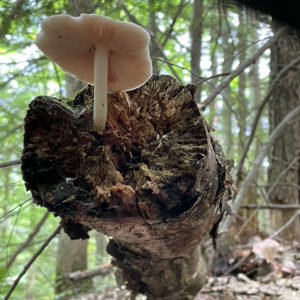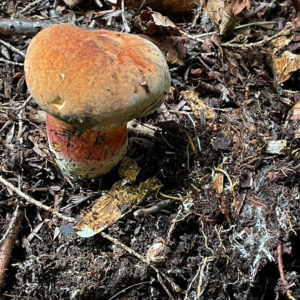What are Fungi?
Say the word "fungus" and what comes to mind? For some gardeners, the word may have a negative connotation, conjuring up images of various diseases, such as the blights that infect tomato plants. Fungi species that cause diseases are called pathogenic fungi, or simply pathogens. Although most garden ecosystems contain some disease-causing fungi, by far there are more beneficial fungi than pathogenic ones.
Healthy soils are alive with an especially diverse array of fungal species, and many are essential to the health of the plants growing in that soil. In fact, a soil devoid of fungi is a dead soil, and is unlikely to support thriving plants. Some soil fungi are single-celled and visible only through a microscope. Others form large, underground networks of filaments that can cover an area the size of a football field or larger. Most of us are familiar with the above-ground parts of some soil fungi: the mushroom.
Mushrooms are the reproductive structures, or fruiting bodies of some types of fungi. They pop up (sometimes overnight) when conditions are right. Mushrooms are akin to icebergs — what you see is a small piece of something much larger. The rest of the mushroom's "body" lives underground within the soil as thin strands called hyphae (HI-fee). Collectively, the hyphae form an extensive network called the mycelium (my-SEE-lee-um). In many cases the hyphae are too small to be seen with the naked eye; however, you may be able to see the delicate white strands coursing through compost, decomposing organic matter, or soil.
Fun Facts about Fungi
- Genetically speaking, fungi are more closely related to animals than to plants.
- In our scientific classification system, they belong to their own kingdom: Kingdom Fungi.
- Humans have just scratched the surface when it comes to identifying and understanding this vast kingdom. It's estimated that there are 2 to 3 million species, yet fewer than 150,000 — less than 1% — have been identified and described.
- Fungi are found worldwide, including in some of the most extreme environments, such as in deserts and in areas with high salt concentrations. Some species have been exposed to — and survived — intense radiation such as that encountered during space travel.
- According to the Guinness Book of World Records, the largest living organism on the planet is a single specimen of honey mushroom (Armillaria ostoyae), which covers 2,385 acres (an area equal to 1,350 soccer fields) in the Malheur National Forest in Oregon. Most of its tissue is made up of underground mycelium, a network of filament-like hyphae.
Types of Soil-Dwelling Fungi
Fungi can't make their own food through photosynthesis, so they rely on other organisms to meet their energy requirements.
- Saprophytic fungi (such as the "decomposers") get their nutrients from dead organic matter.
- Mutualistic fungi (such as mycorrhizae) get their nutrients via a mutually beneficial relationship with living plants.
- Parasitic fungi also get their nutrients from living plants, but unlike mycorrhizae, they do so at the expense of the host organism. If the fungi cause disease, they're called pathogens.
The Decomposers
Imagine if all the fallen leaves, downed trees, and other dead organic matter were to remain intact, year after year. It wouldn't take long before we couldn't walk through the woods — or even our backyards! Fortunately, those materials break down over time, just like the organic matter in our compost piles or the pile of leaves we raked up in the fall. The overall mass of these materials dramatically decreases and we're left with dark, rich, crumbly compost. But how?

Growing out of a fallen tree branch, this mushroom indicates the presences of a "decomposer" fungus.
Soil fungi are major players in this ecosystem drama, and are often first on the scene. Although many microbes play a role, soil fungi are responsible for starting the process of breaking down dead plant material — everything from delicate leaves to tough tree stumps — into simpler components. In the process, they release the nutrients that were bound up in those plants so that successive plants can use them. This transition of nutrients from plant material, into soil, and then back into plants is called nutrient cycling.
In particular, some of these first-on-the-scene soil fungi have the ability to break down tough plant components, such as the lignin and cellulose in woody plant residues — substances that other microbes aren't able to tackle. Once the initial decomposition occurs, the rest of the players, including various fungi, bacteria, and other microbes — are able to complete the process, eventually creating nutrient-rich humus.
Mycorrhizae
The underground hyphae of mycorrhizal fungi colonize plant roots. In doing so, they not only draw from the plants' nutrient reserves, they also extend the plants' reach into the surrounding soil, helping the plant mine the soil for water and nutrients. Learn more at Mycorrhizae and Plants.
Parasitic and Pathogenic Fungi
Some species of soil-dwelling fungi cause harm to their host plants. Parasitic fungi draw nutrients from their hosts, weakening the plant in the process. Many parasitic fungi are also pathogens; that is, they cause diseases. For example, fusarium and verticillium are two types of soil-borne fungi that can infect tomato plants, reducing yield and potentially killing their host plants. One way these soil fungi spread to the plants' foliage is when heavy rainfall splashes soil up onto the stems and leaves, transporting fungal spores in the process. (Spreading a thick layer of straw mulch around plants reduces soil splashing, which in turn helps control the spread of these diseases.)
In gardening and agriculture, preventing the spread of parasitic and pathogenic fungi through cultural techniques is important. (Cultural techniques include mulching, proper watering, and adequate plant spacing.) Although chemicals that kill fungi (called fungicides) are available, these treatments also impact beneficial soil life, and if they're used repeatedly the soil may eventually "die" — becoming devoid of the microbial life that so dramatically helps plants thrive. When soils die, at best the crop plants require far more fertilizer and water. At worst, the plants die too.
Healthy Soil, Healthy Plants
Scientists are still learning about the importance of fungi to healthy soil. The underground ecosystem is complex and ever-changing. The balance of fungi, bacteria, and other organisms is influenced by many factors, including soil type and climate. It isn't an overstatement to say that if we want to eat, we need to nurture healthy soil ecosystems that can support healthy plants.





